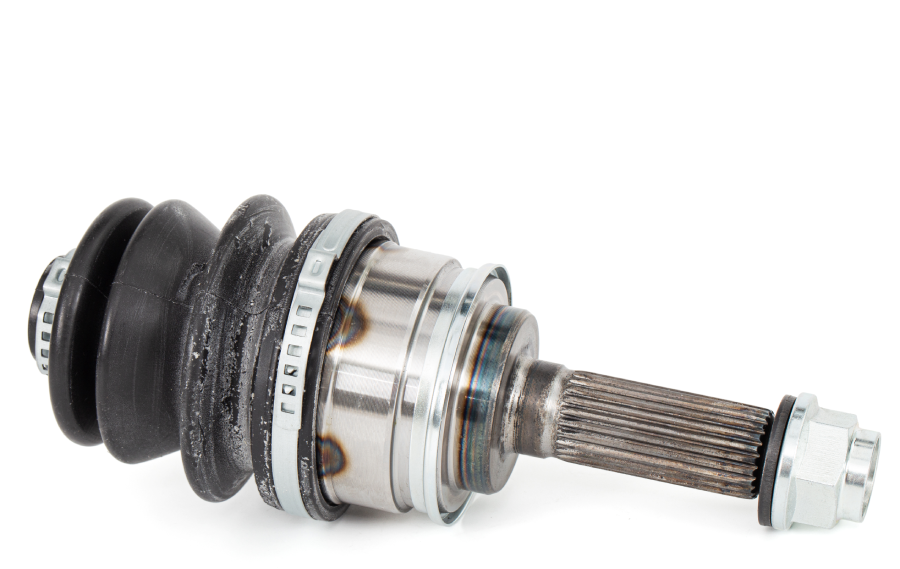CV Joints vs Universal Joint: Comparing Driveline Components
Date Posted: 18 October 2023

If you want a safe and comfortable drive, two of the many parts you’ll want in place are the CV (constant velocity) joint and the universal joint. Sitting at the heart of your vehicle’s driveline, these critical components serve vital functions to keep things moving — though they couldn’t be more different. If you examine each part from a design, application or performance point of view, you’ll notice some stark differences. In this blog, we’ll delve into the world of CV joints and universal joints, comparing these driveline components in terms of their roles, advantages, and disadvantages. We’ll also break down some signs of potential breakdown and discuss when it’s time to replace failing joints.
Knowing the CV Joint (Constant Velocity Joint)
The CV joint, which attaches to the CV drive shaft, is a fundamental component in modern vehicles. It plays a particularly important role for vehicles with front-wheel drive (FWD) or all-wheel drive (AWD) systems. The CV joint’s primary purpose is to facilitate the transfer of power from the transmission to the wheels while accommodating various angles and motions. These can include those encountered during steering and suspension travel.
Pros of CV Joints
As the name suggests, CV joints maintain a constant velocity during rotation. This means they provide a smooth transfer of power, even when the wheels are at different angles, to ensure a vibration-free and efficient drive.
CV joints can also handle the up-and-down motion of the suspension system, as well as the steering angles of the wheels, which makes them ideal for FWD and AWD vehicles.
Cons of CV Joints
Housed in protective rubber boots filled with grease, CV joints are high-maintenance. You will need to inspect and maintain the boots regularly to prevent dirt and contaminants from entering and causing wear or damage to the joints.
Moreover, while CV joints are excellent at accommodating moderate angles, they may not be suitable for extreme angles and heavy-duty applications.
Knowing the Universal Joint
The universal joint, commonly known as the U-joint, serves a different but equally essential purpose in vehicles. It connects two shafts at an angle, allowing for rotational movement in multiple planes. You will often find universal joints in the driveshafts of rear-wheel-drive (RWD) and four-wheel-drive (4WD) vehicles.
Pros of Universal Joints
Universal joints provide flexibility and are well-suited for applications where shafts must transmit power while not in a straight line. They can accommodate a broader range of angles compared to CV joints.
Universal joints are also robust and reliable, which makes them suitable for heavy-duty applications and off-road vehicles.
Cons of Universal Joints
When operating at high angles, universal joints can introduce vibrations into the driveline, which may lead to discomfort and potential long-term damage.
Moreover, unlike CV joints, universal joints do not maintain a constant velocity during rotation, which can result in driveline vibrations and wear over time. This goes double if they’re operating at extreme angles.
Signs of Failure
If you want to keep your driveline intact and avoid costly repairs, it’s crucial to know the signs of CV joint and universal joint failure. Here are some common warning signals for both components:
CV Joint Failure Signs
- Clicking or popping noises: A clicking or popping sound when turning can indicate a worn or damaged CV joint.
- Vibration: Excessive vibration during acceleration may suggest CV joint wear.
- Torn or damaged boots: Inspect the CV joint boots regularly for tears, cracks, or leaks of grease, as these can lead to premature failure.
Universal Joint Failure Signs
- Clunking or thudding sounds: Loud clunking or thudding noises while shifting gears or accelerating may point to a failing universal joint.
- Vibration: As universal joints wear, they can introduce vibrations into the vehicle, especially at high speeds.
- Play in the driveshaft: If there is noticeable play or movement in the driveshaft, it could be a sign of universal joint wear.
The Bottom Line
While both CV joints and universal joints play vital roles in a vehicle’s driveline, they have distinct advantages and disadvantages. CV joints excel in maintaining constant velocity and accommodating suspension motion, which makes them ideal for FWD and AWD vehicles. On the other hand, universal joints provide flexibility and durability, which makes them suitable for RWD and 4WD applications.
Understanding the differences between these components, as well as recognising signs of failure, is essential for vehicle maintenance and ensuring a safe and smooth driving experience. If you’re picking up on any of these signs, it may be time to restock on CV joints and universal joints. If you’re ever needing an aftermarket car part, you can count on Machter to provide the quality goods. Head on over to our store and peruse our extensive range of CV joints and universal joints to ensure a safer driving experience.





